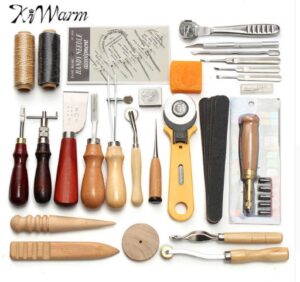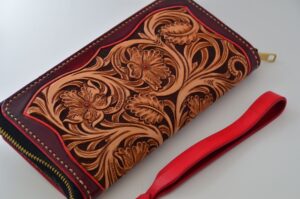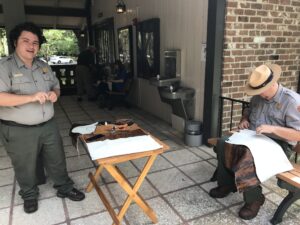
Tom has been leading a leather working class at Fort Frederica National Monument. Although the grounds are open, we still don’t have the buildings open and there aren’t any tours or programming. We are taking advantage of this “down” time to do some training. Tom recently taught the three rangers (and one intern) how to sew leather.
When you look at leather working, there is a ton of stuff to learn. Like most crafts, there are lots of specialized tools. Because leather is so heavy, you need sharp cutting tools. Before you can stitch leather together, you have to make the holes with an awl. You can stitch with sinew or heavy thread. All of this, of course, doesn’t even begin to touch the embossing, engraving and hand-tooling you can do to really make a leather work of art.
Tom, of course, does historical leather working. After much research, he found out that the British soldiers in the 1740’s would use a cowhide knapsack to keep bedding and clothes dry as they were marching. You can buy a replica knapsack for $200 or you can buy a cowhide for $200 and make four or five knapsacks from it. Guess which one Tom did.
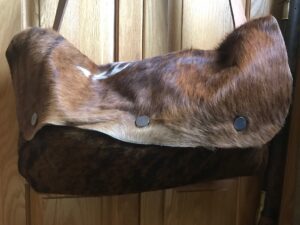
Last year, on one of our drives back to Ohio from Fort Necessity, we stopped at Tandy Leather in Pittsburgh and bought a really pretty brindled cowhide. Tom make two knapsacks from it. Then, last week, he cut up the rest of it so Rangers Casey and Matt could make their own knapsacks. Tom made one more, as well, and Ranger Ellen and Intern Sydne took the larger leftovers to make their own leather creations.
The rangers spent most of two days sewing and finishing their creations. The finished knapsacks can hold a blanket and a change of clothing. Sydne made a long, skinny bag that we all agreed looked like a wine bottle holder. Ranger Ellen made a purse or half-sized knapsack. They are all sturdy and look like they will hold together pretty well.
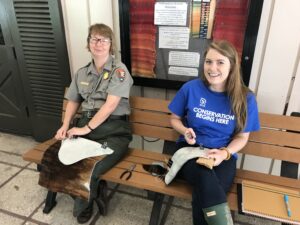
The rangers all enjoyed learning the first steps in a new skill and Tom enjoyed teaching them. Lots of visitors stopped to talk to them about what they were doing. Ranger Michael bought a leather working tool kit along with some animal skins so the rangers can continue to develop their skills. So now the rangers can add leather working to their list of living history demonstrations.

